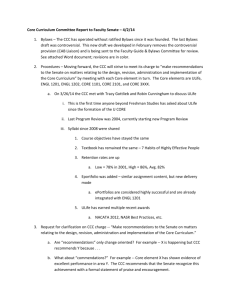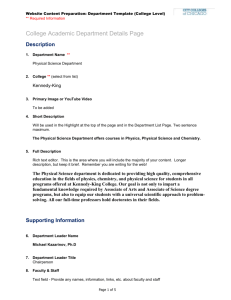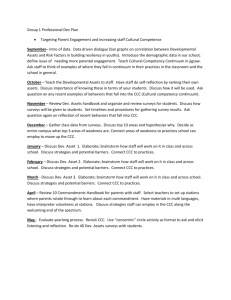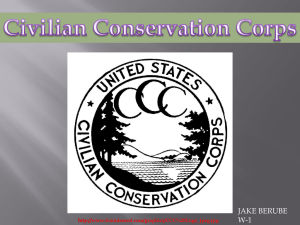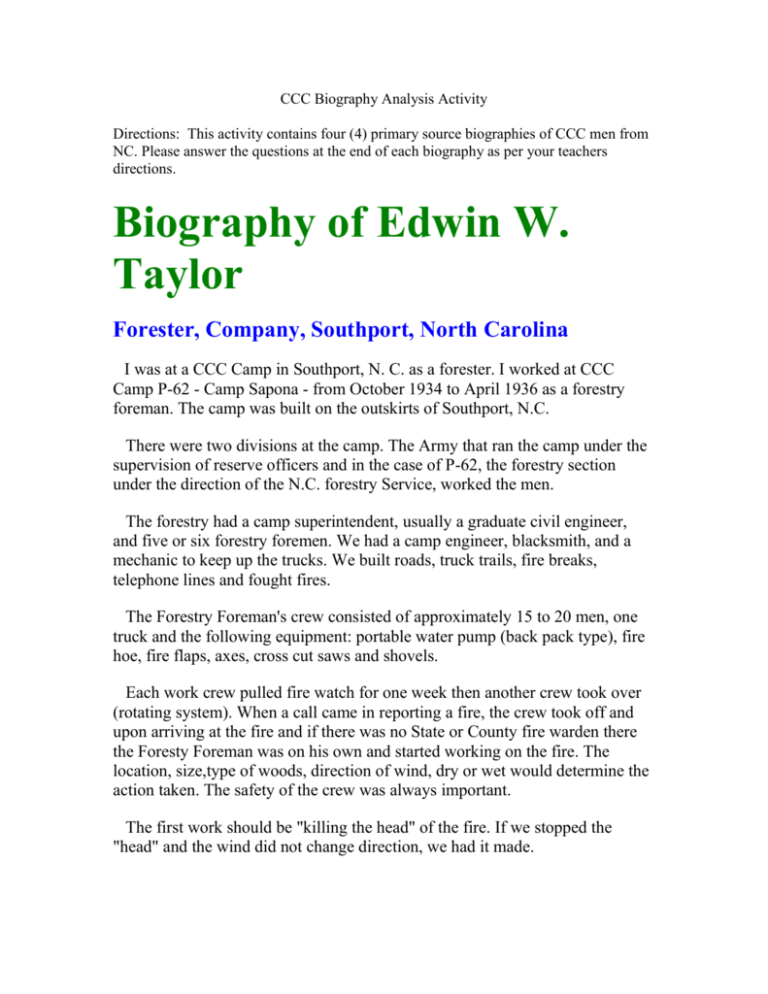
CCC Biography Analysis Activity
Directions: This activity contains four (4) primary source biographies of CCC men from
NC. Please answer the questions at the end of each biography as per your teachers
directions.
Biography of Edwin W.
Taylor
Forester, Company, Southport, North Carolina
I was at a CCC Camp in Southport, N. C. as a forester. I worked at CCC
Camp P-62 - Camp Sapona - from October 1934 to April 1936 as a forestry
foreman. The camp was built on the outskirts of Southport, N.C.
There were two divisions at the camp. The Army that ran the camp under the
supervision of reserve officers and in the case of P-62, the forestry section
under the direction of the N.C. forestry Service, worked the men.
The forestry had a camp superintendent, usually a graduate civil engineer,
and five or six forestry foremen. We had a camp engineer, blacksmith, and a
mechanic to keep up the trucks. We built roads, truck trails, fire breaks,
telephone lines and fought fires.
The Forestry Foreman's crew consisted of approximately 15 to 20 men, one
truck and the following equipment: portable water pump (back pack type), fire
hoe, fire flaps, axes, cross cut saws and shovels.
Each work crew pulled fire watch for one week then another crew took over
(rotating system). When a call came in reporting a fire, the crew took off and
upon arriving at the fire and if there was no State or County fire warden there
the Foresty Foreman was on his own and started working on the fire. The
location, size,type of woods, direction of wind, dry or wet would determine the
action taken. The safety of the crew was always important.
The first work should be "killing the head" of the fire. If we stopped the
"head" and the wind did not change direction, we had it made.
In the early 1930's fire control was just getting started. There was no
equipment as we have today. Just a few telephones and no radios. Usually we
had three or four large fires - 50 acres or more and a small fire - 25 acres or
less.
We lived in army type barracks and had our meals in the officers' mess along
with the army officers. We had a mess orderly and a barracks orderly.
There were very few problems with all involved at this camp. We had a great
bunch of men at P-62 , for the most part.
----- Edwin W. Taylor
ewt_helen@yahoo.com
Copyright 1999, 2000, 2001 John Justin, All Rights Reserved
Questions
1. What tasks were Edwin W. Taylor’s CCC men in P-62 assigned with? (10 pts)
2. Mr. Taylor states that fire control was just getting started at this point in American
history; evaluate why you think this is the case? Think- There has been huge
tracts of forests in the country for thousands of years, what changed so that people
began to think that putting out the fires was now important? (15 points)
Biography of James
William Biggs
Leader, CCCMan, Company 411, Camp NP-5-NC,
Camp Kephart Prong, Great Smoky Mountains
National Park, Bryson City, North Carolina
In 1933 when I, James William Biggs, was about 21 years old, I was living in
Newland, North Carolina. My dad and I were farmers. We had 50 acres on
which we raised cabbage, corn and potatoes. We sold vegetables and certified
seed potatoes. It was hard to live in that area of North Carolina because of the
cold climate, the isolation of the area, and also because of our Republication
president who was starving the country to death.
I heard about Roosevelt's new CCC program and I went into the town of
Newland, about 2 miles away and signed up for a job with the CCC's. I was
given a medical examination. One week prior to the time I was to leave for
camp I found out that I was accepted! A "government man" took me to
Asheville, NC where I got on a government bus that took us to the Smokies. I
had been through the Smokies once before. I was offered a job there since it
was the closest CCC Camp to my home and there was so much work to be done
there. The Great Smoky Mountains National Park was just getting formed and
they were building road, trails, tunnels, rock walls, etc. That is when I first
learned to lay rock. I was taught by government employees. My pay was $30
per month. Twenty-five dollars was sent home and I got $5 of my pay. After
about 6 months on the job, I was recommended for a raise to $45 per month
and I was then allowed to keep $20 of it.
I learned a good trade in the camp. My uncle, Wes Johnson (mother's brother)
also laid rocks in Avery County. Working with him some, I had gained a little
previous experience in rock masonery. In the Camp we had GOOD rocks and
GOOD tools (provided by the government). I liked it when you had good tools
and rocks to work with. Because of this training, I became a professional rock
mason and earned my living doing that for over 40 years.
For recreation the government bus would take us to Bryson City to the
theater, once a week, on Saturday night. Bryson City was the nearest town.
Smokemont was more or less a community, a settlement...no actual town was
located there. The camp was nearest Smokemont, but the nearest town to trade
and do business was Bryson City.
My wife's father, Bill Cline, was also a night watchman at Clingman's Dome
for several years while rock work was being done in the Park. Valuable
equipment was kep there and it was very important to guard it against theives
and vandalism. "Pop Cline" as Bill Cline was called, stayed on the top of the
mountain during several winters guarding property of the government. His
wife, Ida Dodgion Cline, stayed with him for awhile but found it too cold and
dreary for her liking.
While working at the CCC's one of the government men took German
measels. He lived at Smokemont and it happened in the winter time. I got the
measels too. The government took three of us German measel patients in an
ambulance all the way to Ft. Oglethorpe, GA. We stopped in Copper Hill,
Tennessee and they got us some whiskey, thinking it would help us. We drove
on to Ft. Oglethorpe and were confined to the "Measels Ward". The ward was
full of people -- 100 or more on cots. Army personnel were jealous of CCC
boys and fights would break out. I was stout and I would try to settle the
disputes! We stayed there about two weeks. They treated us with shots and
pills. We came back in the ambulance and continued to work in the CCC
Camp.
Men of CCC Camp Kephart Prong, CCC Company 411
In the photo, I am second from the left, front row (the best-looking one!). My
shirt says "411 CCC". I was the leader of 10 boys. Ben Cannon is the man
beside me who also has on a shirt that says "411 CCC". Next to Ben is Stafford
Clark, also from Newland, NC. I recommended him and got him into the
CCC's. He lived across the hill from me in Newland. He wore size 13 shoes,
size 6 hat, and 32 waist pants. On the back row, second from the left is
"Champ" Rice.
I stayed in the CCC's for two years and then asked for a discharge. After
being discharged, I went back home to Newland for a few months. I had a big
bunch of money saved up and so I came over to Bryson City and got married.
On November 5, 1935, I married "Pop Cline's" daughter, Ida Wilson Cline.
Johnny Hyatt married us at the Ela Baptist Church. I sent someone to a local
restaurant and bought $30 worth of food and we all ate outside the church that
day. We were married for 56 years until Wilson passed away in 1991.
----- James William Biggs
biggsbc@swain.main.nc.us
Copyright 2002 John Justin, All Rights Reserved
http://www.geocities.com/oralbio/biggsjwbio.html
Questions
1. Why was the CCC important to Mr. Biggs later in life? What skills did he learn in
the CCC that he used for the rest of his life? (10 pts)
2. Mr. Biggs blames the economic hardships that led him to the CCC on the
previous Republican President whom Mr. Biggs believes was trying to destroy the
country. Evaluate: Many people hurt by the Depression changed political parties
once they were helped by the New Deal. Create a list of three events that you
believe would cause people to change political parties and WHY those events
would cause people to change parties. (15 pts)
Biography of Simon Bland
Pearce
Enrollee, Company 411, Camp Kephart Prong, Camp
NP-5, Smokemont, North Carolina
My father, Simon Bland Pearce was from Youngsville, North Carolina, born
on June 21, 1911. He joined the Civilian Conservation Corps when it was
started, begining work on June 5th, 1933 constructing roads and bridges. He
was a Member of Company 411 Kephart Prong, NC. The Camp was nineteen
miles from Kephart Prong and the nearest post office was Smokemont, and the
nearest Railhead was Bryson City. Their project was the Great Smokey
Mountain National Park.
After the CCC he went to work for and completed 38 years of service for the
Seaboard Railroad. He married Mary Susan Pearce. He passed away on January
19th, 1986. I am his oldest son.
I have an annual with some photographs of the camp and a Roster (linked
below). I also had the pleasure of recently visiting the Kephart Prong Trail off
441 near Cherokee, NC. There are remnants of CCC camp 411 all along the
trail. They include foundations, chimmey,water fountain, and other remnants. I
plan on returning this summer to take some more pictures.
----- Carl Pearce
carl777@bellsouth.net
Copyright 2003 John Justin, All Rights Reserved
http://www.geocities.com/oralbio/pearcesbbio.html
**** Note: the pictures described in the biography are not linked here; please go to
website above and follow links if desired.
Questions
1. At one time, the CCC had 22 groups working in what would become the Great
Smoky Mountains National Park. The land that became the park was over 2/3
logged by timber and furniture companies. Look at the picture below
Picture from the CCC Photo Archives; FDR Library Hyde Park, NY
Evaluate: This is an actual picture of the accepted practices used by corporations in
the NC mountains prior to the New Deal and the CCC. There are some people and
corporations that would like to return to this practice. Write a paragraph(s) in which
you state whether clear cutting on this scale should be allowed. Include three reasons
why or why not. (25 pts) Hint: Feel free to include some information you learned in
science!!!!!
Biography of Elias W.
Covington
Leader, Company 4520, Fort Bragg, NC & Company 429, Yanceyville, NC
& Roxboro, NC
Captain, USA
Based upon an article in the NACCCA Journal, which in turn was a reprint of
an Article in the American Visions, The Magazine of Afro-American Culture,
forwarded by Capt. Covington
I was working for 50 cents a day in 1935. My father had died, and I had to
take care of my mother and a younger brother and sister. But in my hometown
of Laurinburg, North Carolina, nobody was making any money. It was a tough
time for all Americans, and especially African Americans who were already
poor to begin with due to discrimination and the aftermath of slavery.
I heard of a new program, the Civilian Conservation Corps, from my local
relief supervisor. The CCCs was created to give people jobs, and thanks to
Oscar De Priest, the only black congressman at the time, an amendment to the
CCC laws made it an organization that would not discriminate by race or color.
If it wasn't for Oscar De Priest, as an African American I would not have been
able to enlist. As it was, however, the supervisor asked me if I wanted to join
the CCC.
The CCCs were going to pay $30 a month, $25 of which would go to my
mother. Thirty Dollars a month was a lot of money in those days. Plus we got
all of our clothes, and a clean bed to sleep in. They also had educational
facilities and a medical officer. So I told him "Yes". He moved my age up,
that’s how I got in. I was 15 years old.
I was sent to Fort Bragg, North Carolina where I joined an all-black
company. The CCC's was completely segregated except a few camps outside
the South.
It was at Fort Bragg that I saw a typewriter for the first time in my life. And
Every time I got a chance, I used it. It opened up a whole new world. Because
of my interest in typing I received numerous promotions in the CCCs.
I was assigned to Company 4520 at Fort Bragg. I was assigned eventually to
kitchen police duty, meaning I was one of the Cooks who prepared three meals
a day for the 200 men in the Company plus the officers and staff.
I next was assigned to duty as an officer's orderly. From there I was moved to
ambulance driver.
I was transferred to Company 429, Yanceyville, NC. After a time our
Company moved to a new Camp in Roxboro, N.C.
I was then made an assistant supply sergeant, from which position I was
promoted to a Supply Sergeant. During these various positions I was promoted
to Assistant Leader and then Leader. Assistant Leaders received $36 a month
and Leaders $45 a month.
I was also appointed to the Army Overhead as a Key Man. Key Men were
allowed to remain in the CCC beyond the two year limit imposed upon other
Enrollees.
As Supply Sergeant I was in charge of all the clothing and equipment for the
Company. I was appointed Supply Sergeant with Company 429 in 1937 and
remained in that position until I was discharged from the CCCS in 1942.
I left the CCCs and joined the Army in 1942. There my experience served me
well. I was promoted to Corporal, through Sergeant and to Battallion Sergeant
Major within 13 months.
After World War II I remained in the Army. I picked up my education and
received a high school diploma and after that a college degree, a BA in Public
Administration, from Upper Iowa University in Fayette thanks to the GI Bill.
I received a direct commission to 2nd Lieutenant with the Corps of Engineers
in 1948. I remained in the Army for over 20 years, retiring as a Captain in
1962.
Although I left the Army I did not leave public service, entering the Civil
Service in 1962 and remaining there until I retired in 1984 as Chief of Division
Logistics with the Department of Health and Welfare Human Services, in
Washington, DC. My Federal Service, including my stint with the CCCs,
totaled over 48 years.
While in D.C. I began my volunteer work with the National Association of
CCC Alumni which was then headquartered in Falls Church, Virginia. Even
though the NACCCA is now in Missouri, I remain a member.
----- Elias. W. Covington, Capt. USA(ret.)
Questions
1. Capt. Covington states that discrimination was severe in NC during the
Depression but the CCC was opened to African Americans. What political impact
do you think the New Deal had upon African Americans politically? Hint: What
political party did most African Americans join after the Civil War as compared
to the political party that most African Americans joined during the Depression
and belong to even today? (5 points)
2. Capt. Covington is another example of a CCC man who seized an opportunity that
opened up the door for success later in life. Construct a paragraph in which you
create a government program or agency that would open the door of success for
you. Remember you have read that the New Deal was never intended to “give”
people a living but was designed to help them gain skills and income so that they
could become self sufficient. (20 points)





